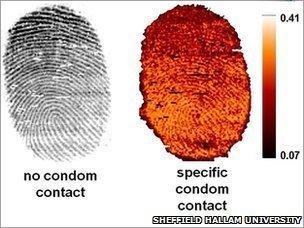Fingerprint breakthrough offers new forensic evidence
- Published

A technology to extract fingerprints from a crime scene could show if a criminal suspect has taken drugs or been in contact with explosives.
Researchers at Sheffield Hallam University have developed a way to capture fingerprints that can identify substances touched, and secretions from a person's body.
This could provide new information about a suspect's actions and habits.
Scientists hope the technology will be available to police within three years.
A fingermark contains not only a pattern of ridges, but also material from the skin surface and human gland secretions. Current police methods can only scan the ridge pattern to compare with database records.
This has limited value, according to lead author Dr Simona Francese: "Someone with a clean criminal record won't be found, and the print can often be distorted."
The new method takes multiple images of a print from many different surfaces, using a technology called Mass Spectrometry Imaging to produce a detailed chemical signature.
"We use a special powder that can recover prints from glass, wood, metal and leather. When we spray a solvent on the powder, it dissolves into crystals containing chemical substances. These can show contaminants such as drugs, explosives or cosmetics on the skin," Dr Francese told BBC News.
Touch test
In one example, scientists were able to confirm if a fingerprint subject had handled a condom. They believe that this could help provide evidence in cases involving sexual crime.
The process also detects drugs that a suspect has ingested - as Dr Francese discovered when she drank a cup of coffee before testing herself.
"I found a caffeine signature on my own prints, which increased as my body absorbed the drink."
Researchers believe that this could be used to detect illegal drugs taken by a subject.
Fingerprint technology has been overshadowed in recent years, as DNA testing has proved a more precise means of criminal profiling. Yet Dr Francese believes fingerprinting has the potential to produce richer information.
"We could provide not just an image, but a story about the criminal - who they are. You'll be able to say a lot more about a suspect than you could."
The UK Home Office has invested £80,000 in further research, and Dr Francese is optimistic that the system will soon be available to police.
"It takes time to integrate every new technology, but my guess is it'll take two to three years for this to happen."
- Published4 July 2011
- Published6 June 2011